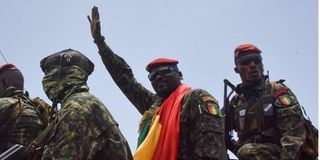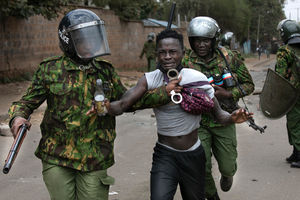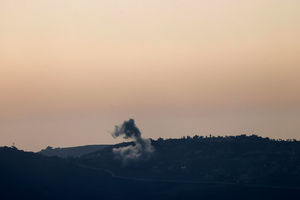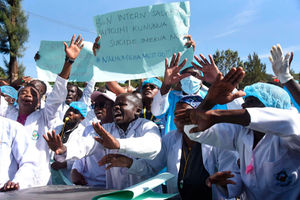What Africa’s coups reveal about us

Guinea's coup leader Mamadi Doumbouya (center). PHOTO | COURTESY
From the start of 2010 to last weekend, the soldiers have made coup moves 37 times in Africa. That is a surprisingly high number, considering that coups d’état are supposedly out of fashion on this fair continent.
Very few of them succeed, though. Counting the ouster of Guinea president Alpha Condé on Sunday by his trusted lieutenant Col Mamady Doumbouya, only nine of them have succeeded. Not bad for an 11-year period, considering that there was a time in Africa when you had nine failed and successful coups in a week.
Of these nine successful coups, five have been in West Africa: February 18, 2010, in Niger; March 22, 2012, in Mali; August 19, 2020, in Mali again; May 24, 2021, in Mali; and the latest, September 5, in Guinea.
On March 24, 2013, there was a successful coup in the Central African Republic; on July 3, 2013, Gen Abdel Fattah el-Sisi did his thing in Egypt; between November 14 and 21, 2017, a slow squeeze coup in Zimbabwe ended Robert Mugabe’s 37-year rule; and on April 10, 2019, the soldiers in Sudan opportunistically crossed the street and joined the people in their protests against Omar al-Bashir, and set him on a long road to misery.
There is a lot of sweat over what it all means. Clearly, we are seeing the old familiar pattern of coups starting in northern Africa, then infecting West Africa, moving into Central Africa, then the Horn, and maybe East Africa which, apart from Uganda and the Indian Ocean island states, was largely spared.
The grievances against regimes that are toppled also sound familiar – corruption, nepotism, clinging to power, abusing the constitution, failing to deal with insecurity, and economic failure. The soldiers, when they take over, rarely do better, and thus as in Mali, the coup and countercoup cycle continues.
There are, however, some revealing differences about today’s Africa’s coup makers, and the soldiers who seized power between the late 1950s and early 1990s. We are not counting here political movements that used weapons, like President Yoweri Museveni’s National Resistance Movement in Uganda or Meles Zenawi’s Tigrayan People’s Liberation Front (TPLF) in Ethiopia. They arose from outside the state, not from within, and are a very different kettle of fish.
Coup leaders today are more educated than many of the first generation of putschists, but they are lesser gentlemen officers. Col Doumbouya in Guinea is typical. He attended nearly a dozen military courses and also served abroad, including in the French foreign legion. But when he showed up, there he was in his dark sunglasses indoors and on TV.
Previously Africa had three broad categories of coup-making soldiers. There were the more socially and economically conservative ones like Murtala Muhammed and Olusegun Obasanjo in Nigeria. They read Shakespeare, were into the classics, and with all their many failures, they were still nation builders.
Then there was the lot in the middle, like Uganda’s Idi Amin and Central African Republic’s Jean-Bédel Bokassa. They were madmen who fed their rivals to crocodiles.
And then there were the radical youthful ones on the left like Thomas Sankara in Burkina Faso, and Jerry John Rawlings in Ghana. They were products of junior officer’s clubs, radical discussion groups, read Karl Marx and Walter Rodney, and were modernisers who were quick to hang reactionaries and imperialist agents.
Today’s coup-makers are not distinct as a product of an ideological or philosophical tradition. It’s no secret why. If you read the history of African militaries. The pool of soldiers in the earlier period, in Uganda for example, were from economically marginalised regions like the north.
Though they were often poorly educated, they brought with them the righteousness of the oppressed and the nobility of victims to the military. And elsewhere you would be recommended by the local chief, and even village elders, to join the military – and police.
From the 1970s many recruits were from youth and student movements, often with a radical bent, or the urban working-class enclaves.
Today, they advertise recruitments into the army and police in the newspapers and on FM radio. In many parts of Africa, when that happens, you have 6,000 young people showing up to fight for 160 places in the army. Some bribe local officials and chiefs to get in line and will collapse from hunger as they wait in queue or undergo physical tests. They are the urban disaffected.
When 6,000 people show up for 160 slots in the army or police, most are not seeking to serve a high purpose. They are looking for a uniform and gun to shake down the people.
Educated though they might be, they will show up on TV, as we saw with Col Doumbouya’s comrades, in gloves, face masks and balaclavas as if they were characters from a modern-day re-enactment of Ali Baba and the Forty Thieves. In that way, they mirror how our societies too have deformed. You ain’t about to get a Sankara.





